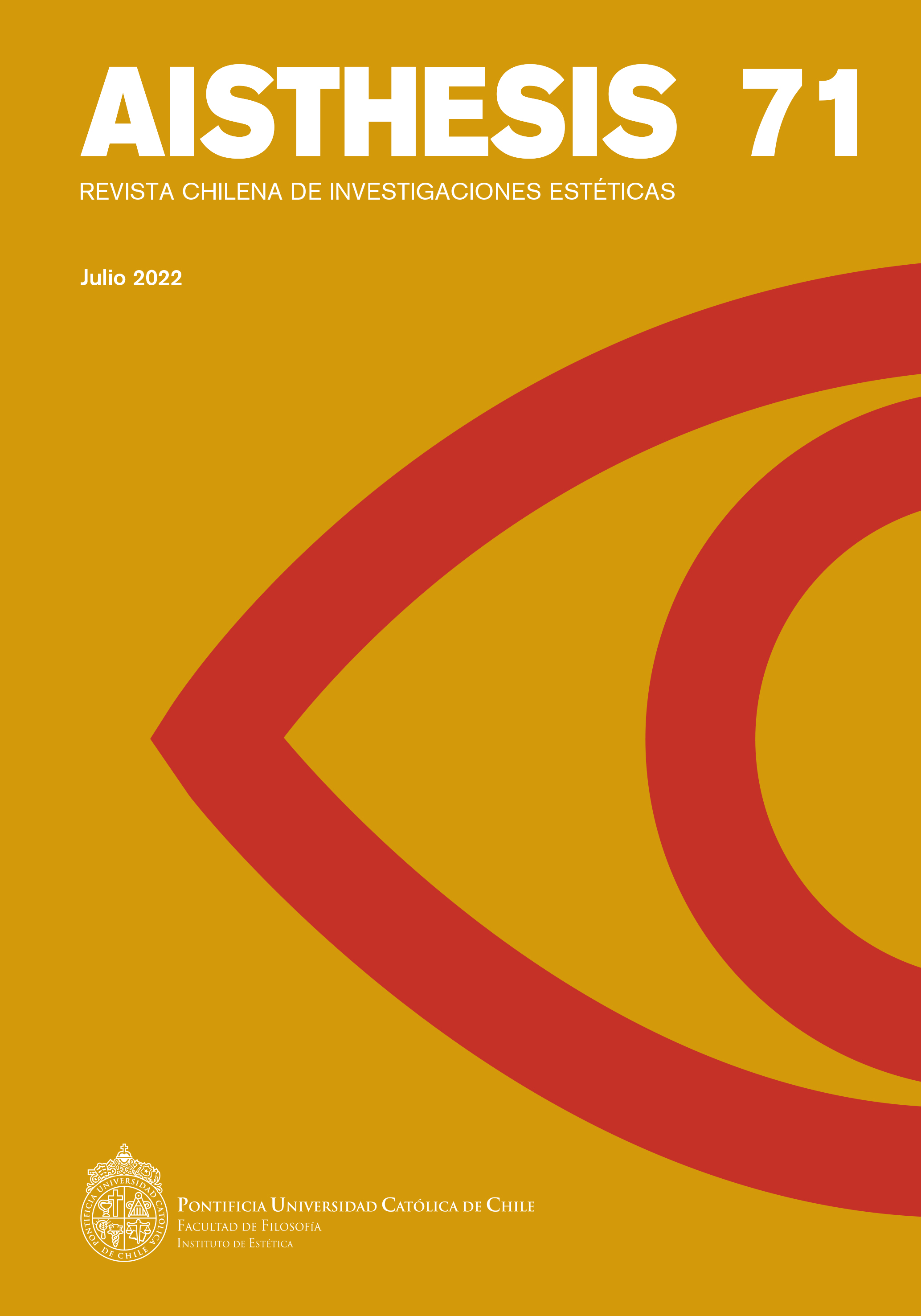Francisco de Goya’s The Confidence: In Light of Three Feminist Perspectives
Main Article Content
Abstract
This essay describes a particular aesthetic experience, based on Goya’s graphic work Confidence; belonging to the series of Caprices and inventions, which are nightmarish landscapes that illustrate the social crisis from the Age of Enlightenment. From here, I will develop a personal hermeneutic that advances through three theoretical scenarios about what the trust of one woman in another would imply, based on image support. The various theoretical theses are located in the orbit of current feminist thought and where three authors will be represented: Muraro, Despentes and Braidotti. Finally, this interpretation device will reveal Goya’s art for a possible review of social criticism on the virtue of trust.
Downloads
Article Details

This work is licensed under a Creative Commons Attribution-NonCommercial-ShareAlike 4.0 International License.
All contents of this electronic edition are distributed under the Creative Commons license of "Attribución-shareAlike 4.0 Internacional" (CC-BY-SA). Any total or partial reproduction of the material must mention its origin.
The rights of academic works published in this publication belong to their authors., who grant to AISTHESIS: Revista Chilena de Investigaciones Estéticas the license for its use. The management of the permits and the authorization of the publication of the images (or of any material) that contains copyright and its consequent rights of reproduction in this publication is the sole responsibility of the authors of the articles
References
Andric, Ivo. Goya. Barcelona, Acantilado, 2019.
Bouttemy, Marie-Françoise, Nicole Van Hoeke, Cordélia Hattori y Alain Tapié, editores. Goya les Caprices & Chapman, Morimura, Pondick, Schütte. Lille, Somogy Éditions D’art, 2008.
Braidotti, Rosi. Sujetos nómades. Corporización y diferencia sexual en la teoría feminista contemporánea. Buenos Aires, Paidós, 2000.
––. Feminismo, diferencia sexual y subjetividad nómade. Barcelona, Gedisa, 2004.
––. The Posthuman. Reino Unido, Polity Press, 2013.
Burlando, Giannina. Dossier Escritos desde un Campus Universitario. Madrid, EAE, 2020.
Butler, Judith. El género en disputa. El feminismo y la subversión de la identidad. Buenos Aires, Paidós, 2016.
Butler, Judith y Marie Lourties. “Actos performativos y constitución del género: un ensayo sobre fenomenología y teoría feminista”. Debate feminista, nº 18, 1998, 296-314.
Calvo Serraller, Francisco, Iglesias, Carmen, Tomlinson, Janis A. y Ribeiro, Aileen. Folleto: Goya, la imagen de la mujer. Fundación Amigos del Museo del Prado ed. Goya, 2001-2.
Castañeda Salgado, Martha Patricia, “Feminismo/Feminismos”. INTERdisciplina, Centro de Investigaciones Interdisciplinarias en Ciencias y Humanidades-UNAM, vol. 4, nº 8, 2016, pp. 9-20.
Castillo, Alejandra. Disensos feministas. Santiago de Chile, Palinodia, 2016.
Decock, Wim. “Trust Beyond Faith - Francisco Suárez on the Legal Bindingness of Agreements with Excommunicates”. Anales, vol. 52, 2017, pp. 114-149.
Deleuze, Gilles y Guattari, Felix. Mil Mesetas Capitalismo y Esquizofrenia. Valencia, Pre-Textos, 2004.
Descartes, Rene. Les Passions de L’Ame. París, Vrin, AT, 1996.
Despentes, Virginie. Teoría King-Kong. España, Melusina, 2007.
Eisenstein, Zillah. Señuelos sexuales: género, raza y guerra en la democracia imperial. Bellaterra, 2008.
Eco, Umberto. “Filosofare al femminile”, La Bustina de Minerva. Milano, Bompiani, 2003. http://www.universitadelledonne.it/filosofare.htm
Falcon, Lydia. “La presencia de la mujer en la política. Mujerismo y Feminismo”. MR Mujeres en red, El periódico feminista, 2011, https://www.elperiodico.com/es/opinion/20110915/mujerismo-feminismo-1150266.
Foucault, Michel. Le corps utopique: Les hétérotopies. París, Nouvelles Éditions Lignes, 2009.
Glendinning, Nigel. Goya la década de Los Caprichos, Retratos de 1792-1804. Madrid, 1992.
Hughes, Robert. Goya. EE. UU., Random House, 2003.
Lafuente Ferrari, Enrique. El mundo de Goya en sus dibujos. Madrid, Urbión, 1979.
Lonzi, Carla. Escupamos sobre Hegel y otros escritos. Madrid, Traficantes de sueños, 2018.
MacKinnon, Catharine A. Hacia una teoría feminista del Estado. Trad. de Eugenia Morín. Valencia, Ediciones Cátedra, 1995.
Marquina, Rafael. “Ortega y Gassett y la crítica de arte”. Revista Cubana de Filosofía, vol. IV, nº 13, 1956.
Millet, Kate. Política sexual. Trad. de Ana María Bravo. Valencia, Cátedra, 2010.
Muraro, Luisa. “La verdad de las mujeres”. Revista Duoda. Estudios de la Diferencia Sexual, Barcelona, nº 38, 2010.
––. Guillerma y Maifreda. Una heregía feminista. España, Omega, 1997.
New Catholic Encyclopedia, Ethics and Philosophy, vol 2. Washington D. C., The Catholic University of America, 2012-13.
Ortega y Gasset, José. Goya. Buenos Aires, Col. Austral, Espasa-Calpe, 1963. Cito al Goya de Ortega publicado en Obras Completas, Tomo VII, p. 5.017.
Palaisi, Marie-Agnès. “Saberes nómades El sujeto nómade como contraespacio epistemológico”. Enrahonar nº 60, 2018, pp. 57-73.
Preciado, Paul B. Un apartamento en Urano. Barcelona, Anagrama, 2019.
Ricoeur, Paul. Soi-même comme un autre. París, Seuil, 1990.
––. Temps et récit 3. París, Seuil, 1985.
Rodríguez de la Flor, Fernando. “Cultura de la melancolía e ideologías del retiro y del desengaño en tiempos del infante Don Luis de Borbón”. Gaceta de Estudios del Siglo xviii, vol. 1, 2013, pp. 8-56.
Seseña, Natacha. Goya y las mujeres. Madrid, Taurus, 2004.
Scott, Joan W. “Gender: A Useful Category of Historical Analysis”. The American Historical Review vol. 91, nº 5, 1986, pp. 1.053-1.075.
Suárez, Francisco. Disputationes de censuris in communi, excommunicatione, suspensione et interdicto itemque de irregularitate, Opera omnia. París, Vivès, 1861.
––. Lectiones De Fide [Colegio Romano, 1583]. Edición crítica de K. Deuringer, Granada, 1967.
Valcárcel, Amelia. La política de las mujeres. Madrid, Cátedra, 1997.
